Our Five Favorite NYC Parks and Why They’re a Big Deal for Surrounding Real Estate
By Terence Cullen May 25, 2016 10:00 am
reprints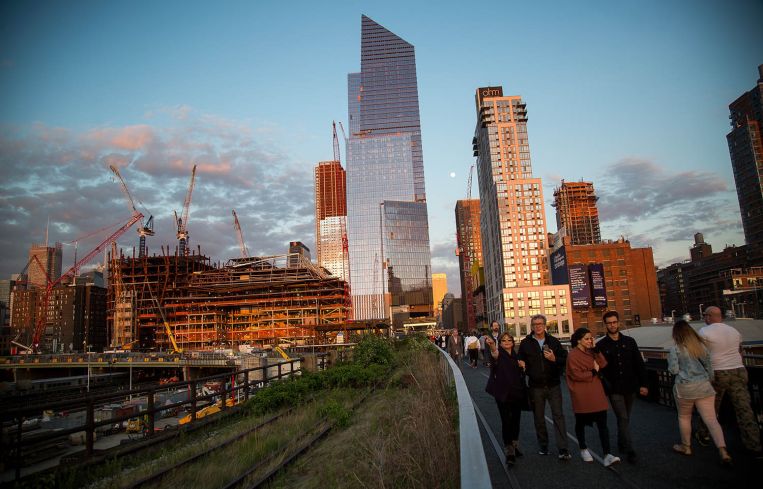
From the moment that the Common Council created the city’s first park at Bowling Green in 1733, New York has had a long love affair with its parks. Of course, its green spaces went through periods of favor and disfavor (in the 1970s and 1980s a park might not have been the place you frequented, especially at night). But since the 1990s, with a major cleanup effort that transformed Bryant Park and Union Square, this New York institution officially went from shady to a nice piece of shade.
While no piece of livable or buildable land is seemingly safe from development these days, new parks are still cropping up all of the time. On the large scale, there is Central Park, the High Line (where architects are weaving the park into their buildings) and Brooklyn Bridge Park in Dumbo. Then there are the small patches in Greenwich Village and the old 7 World Trade Center footprint, where Rudin Management Company and Silverstein Properties, respectively, have built new parks.
What do they mean to the surrounding real estate when it comes to value, quality and location?
“The state of the parks is different every place” in the city than in preceding decades, said Tupper Thomas, the executive director of advocacy group New Yorkers for Parks. “[Today] they are very, heavily used in every part of the city. The parks have become a very central part of everybody’s life.”
The real estate industry has surely benefited when buildings are in close proximity to a blossoming park. With Memorial Day weekend, the unofficial start to summer, upon us, more office workers will be itching to leave their cubicles and the new HVAC system it seems every landlord has put into every building. They’ll cross the streets to take their lunch break in these urban oases.
But they also have a strong economic effect. In 1999, 11th and 12th Avenues were almost a wasteland with a few art galleries and buildings that were far enough from public transportation to provide cheap commercial and residential rents. But when Joshua David and Robert Hammond kicked off their nonprofit called the Friends of the High Line, they planted seeds along the avenues that went well beyond the tall grass and wildflowers on their elevated park. Some of the greatest architects and builders from around the world wanted a piece of that park, and some still are vying to draw on it.
Just how much value does a park add to its surrounding real estate? “Office buildings with views of the 843-acre Central Park command a premium compared to the rest of the office leasing market,” said Cushman & Wakefield’s Richard Persichetti in this week’s Stat of the Week. “Analyzing the office buildings around three other parks within Midtown and Midtown South reveal similar results, as the average asking rent of $92.16 per square foot for buildings surrounding Union Square, Madison Square and Bryant Park are $20.16 per square foot higher than the Manhattan average.”
Here’s a look at our five favorite parks this year and what they mean for the surrounding areas.
Bryant Park
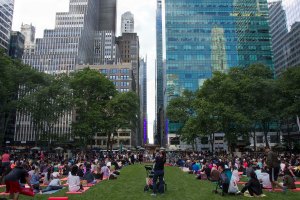
When the Durst Organization built 1133 Avenue of the Americas in 1970 and 1155 Avenue of the Americas in the early 1980s, Bryant Park was a liability to the landlords because it was rampant with drugs and crime. A turnaround effort that began in 1980 started to clean up the park, and by 1982 The New York Times noted that crime in the 9.6-acre park had dropped significantly.
Real estate surely has benefited from this second act that Bryant Park, named for 19th century newspaper publisher William Cullen Bryant, has had in the last 30 years or so. Bearing the Bryant Park moniker has become particularly hot in the last decade, starting with Durst’s One Bryant Park—the 2.3-million-square-foot tower occupied by Bank of America that opened in 2008. Since that time, landlords in the area have gone through a renaming frenzy to attach their properties to the park. There’s also 1065 Avenue of the Americas, now 5 Bryant Park; 1095 Avenue of the Americas, now 3 Bryant Park; and 1071 Avenue of the Americas is 4 Bryant Park. Bank of China’s 7 Bryant Park, which was developed by Hines, opened last year as the final office parcel to be developed on the now coveted park.
“It’s just an incredible amenity for our tenants,” a Durst spokesman told Commercial Observer, “and has generated an incredible amount of value for the real estate around the park.”
That value really augmented last year when Blackstone Group agreed to sell the 415,000-square-foot 3 Bryant Park to Ivanhoé Cambridge and Callahan Capital Properties for a whopping $2.2 billion. Later this year the building will become home to a Whole Foods—a far cry from the type of crowd around the park 35 years ago.
High Line
Just about every tourist who sets foot in this city (and every developer with any plans for the Big Apple) can only seem to talk about this park on the Far West Side. The former rail line has been transformed into one of the most prominent tourism destinations in the city. So popular, that it’s even made a 2012 Simpsons episode during one of the family’s trips to New York City.
The mile-and-a-half-long walkway weaves through a string of existing and under-development properties from the Meatpacking District, through Chelsea and all the way up to the development in the Hudson Yards area.
“The High Line has become an enormous and a terrific thing for New York,” Ms. Thomas said. “It’s got a billion tourists who go to it. The languages you can hear [spoken] on the High Line are amazing.”
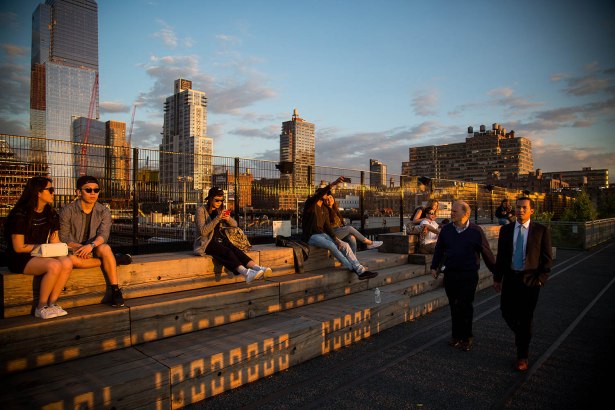
Developers and architects are now starting to incorporate the park into the buildings that are popping up along the High Line like dandelions. Take for instance Tishman Speyer’s 2.9-million-square-foot tower dubbed the Spiral, which is slated for the northern end of the park between West 34th and West 35th Streets. Starchitect Bjarke Ingels wove the trees of the High Line into the 1,005-foot skyscraper to bring nature all the way to the top.
“The linear park will appear to carry through into the spiral of the tower,” Mr. Ingels explains in a video that unveiled the rendering, “forming an ascending ribbon of lively green spaces—extending the High Line into the skyline.”
The Battery
The Financial District is the oldest commercial district in the city, from the Native Americans who fished in it, to the markets of the early Dutch and English Settlers and lastly the financial firms that long populated Lower Manhattan. Throughout that time there has been the Battery, which is officially the city’s oldest continuous park, according to Warrie Price, the president of The Battery Conservancy.
The organization has embarked in the last 20-plus years to revitalize the centuries-old green space. Throughout that time, Ms. Price noted that Downtown has endured 9/11, the financial meltdown of 2008 and Superstorm Sandy. The park was able to survive all of those things, as was the greater Lower Manhattan community. And with the opening of the SeaGlass Carousel last summer and the new lawns this spring, it’s become a retreat for Downtown workers.
“Lots of people had their bagged lunches and were sitting on benches today,” Ms. Price said at the end of a spring day last week. “It symbolizes Downtown—the Downtown that survived all those historic moments but [also] the Downtown that is thriving so newly.”
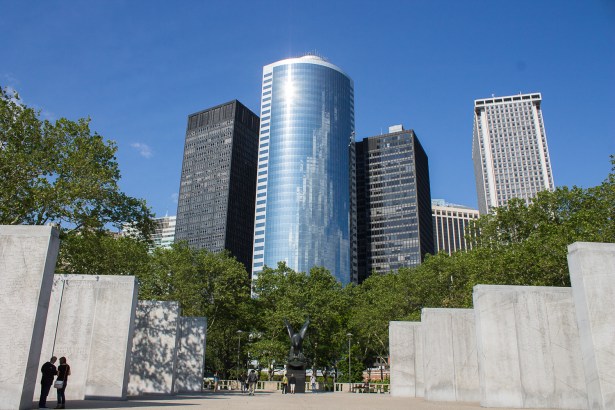
Rudin Management has been active in the park’s overhaul, especially since it owns several buildings facing or near the park: One Battery Park Plaza and One Whitehall Street (the latter is the building where Commercial Observer is based). William Rudin, the company’s chief executive officer who serves as chairman of The Battery Conservancy, said parks have become a natural amenity for landlords, as well as for companies trying to retain talent.
“The parks, whether it is Madison Square or Battery Park, are all really, very, very important [to] help enhance the value of our real estate,” Mr. Rudin said. “It is really critical because the companies today are looking to attract and retain the best employees. In order to do that, you have to have cool office space, great infrastructure, but you need amenities and you need open space and places for people to go and get fresh air.”
Ms. Price said that while Rudin, the late-Melvyn Kaufman of the Kaufman Organization (who developed 17 State Street) and his widow Elizabeth Atwood have been active in the park, other real estate players have not been as active in donating to and helping boost the Battery.
“We would like to have a lot more real estate investment when they are really reaping the benefits,” she said. “We hope that real estate will take a great look at us and look at the benefit of these 25 acres and contribute to their care now.”
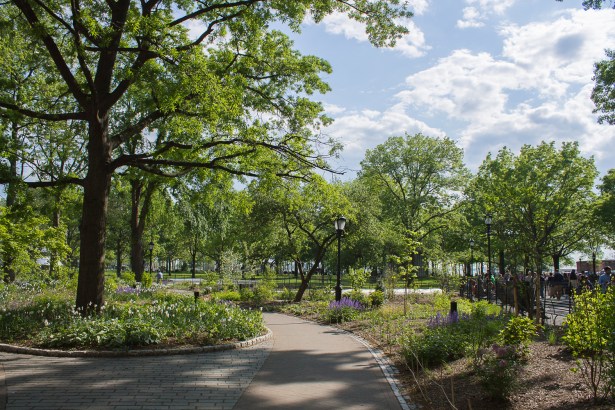
Madison Square Park
Things historically weren’t particularly spectacular for a very long time in and around Madison Square Park in the Flatiron District, which runs from East 23rd to East 26th Streets and Madison to Fifth Avenues.
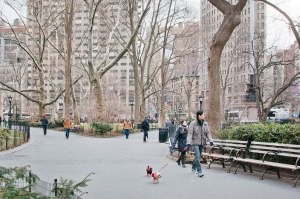
When Rudin Management Company opened 41 Madison Avenue between East 25th and East 26th Streets in 1974, the 500,000-square-foot property was empty, said Mr. Rudin, whose company is active in the Madison Square Park Conservancy. That might make some do a double take today since the Flatiron District—especially around Madison Square Park—is now one of the hottest neighborhoods in the city with some of the highest commercial asking rents.
“The market had collapsed, the park was in disarray” when 41 Madison Avenue opened, Mr. Rudin said. “The creation of the park conservancy [in the 1990s] to really focus and renovate it and curate it has had a tremendous impact on the whole area. Obviously the Madison Square Park area is one of the hot neighborhoods in the Flatiron District.”
The park is also the birthplace of Shake Shack, where it opened as a permanent food stand in the park 12 years ago. The now-public burger company has more than 60 locations around the world. Italian food hall and market Eataly opened across the street from the park in 2010 at 200 Fifth Avenue between West 24th and West 25th Streets, followed by a Lego store next door two years later.
The value of properties near the park has skyrocketed as of late. Last year, SL Green Realty Corp. paid $2.29 billion for the 1.1-million-square-foot 11 Madison Avenue between East 24th and East 25th Streets—the largest single-asset sale in New York City for 2015.
Brooklyn Bridge Park
Ask people about what’s made Dumbo successful and one of their first responses is Brooklyn Bridge Park, the eight-year-old brainchild of the city and the state. The 85-acre site runs more than a mile along the East River and has drawn in tourists and office workers from such places as Etsy and West Elm. That being said, the park still has an outer-borough flavor to it. Last year, Two Trees Management Company installed a yellow sculpture that reads “YO” when seen from Manhattan and “OY” when viewed from Brooklyn.
“I’ve never seen anything like this,” said Christopher Havens of Citi Habitats’ commercial division, who ran commercial leasing for the Dumbo-based Two Trees from 2002 to 2007. “It’s a bigger thing, too, to make Downtown Brooklyn, Dumbo and eventually the Navy Yard area a powerful and attractive office district.”
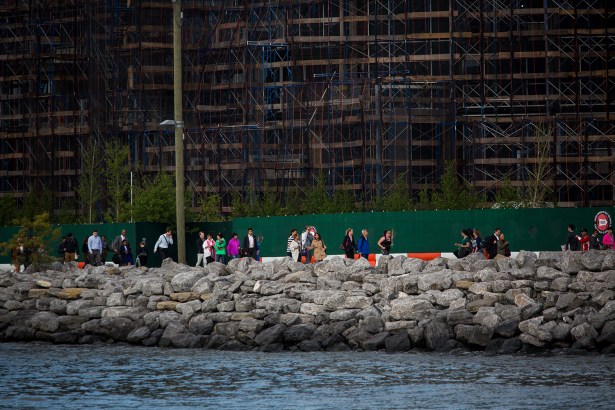
Since the park opened in 2008, new and repurposed development has been taking off in Dumbo, where the park starts before moving south along Brooklyn’s shoreline, like Midtown Equities’ Empire Stores—a 19th century coffee warehouse that’s being converted into an office building that sits directly on the park. When it’s done, the property will be home to West Elm and the New York City offices of advertising firm 72andSunny.
Ms. Thomas, who ran Prospect Park for 30 years before joining New Yorkers for Parks, said she wasn’t initially sure Brooklyn Bridge Park would be successful—or whether it would only be for tourists looking for clear views of Lower Manhattan. While those building-gazers are indeed there, she noted that workers in the area also frequent the park at all times of day.
“It is beyond the beyond,” she said. “It’s a fabulous mix of people. It really works.”



